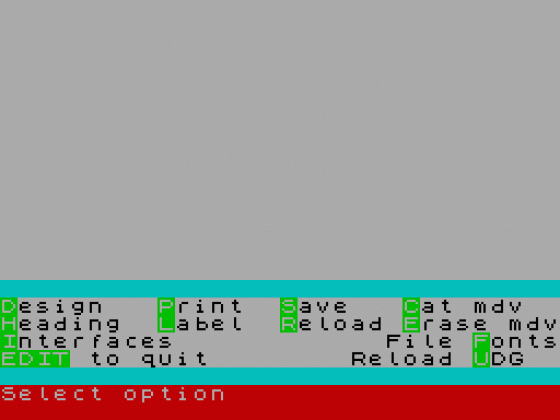
ZX Computing
 1st April 1987
1st April 1987
Categories: Review: Software
Publisher: Bradway
Machine: Spectrum 48K
Published in ZX Computing #36
Lettahead+/Dumpy
Recently, Carol Brooksbank gave some beautiful examples of screen dumps, posters and tickets, with hints on how to produce them (ZX, Feb 87). One of the difficulties of this sort of thing is that you need a good collection of dump routines to fit your printer/interface combination. As there are lots of interfaces and printers, you can be left with quite a problem to get your masterpiece printed, sometimes soluble, it's true, but only if you are prepared to spend a lot of time.
Bradway Software have been producing programs that are, literally, just the ticket. Two programs in particular sort out virtually all these sorts of problems, enabling you to produce a variety of machine code dumps in an enormous range of printer/interface combinations.
Letta-head plus is designed primarily to allow you to print letterheads, labels or small tickets. A special feature lets you produce labels, three in a row if necessary, and a variant of this gives you ready-outlined cassette labels.

Cassette, microdrive or Opus disc versions of the programs are available for an additional £1.50. Typical of the care taken to cover all combinations is the inclusion of a Wafadrive version on side B of the cassette; this is because the Wafadrive uses much more of the Spectrum RAM for its system variables, buffers and directories than a microdrive, and it was therefore impossible to include the Wafadrive printer interface version within the main program.
The program itself comes with a choice of five assorted print styles already available, and a further twenty replacements which can be selected from a menu and loaded: or you can load in your own favourite fonts or use a font-editing/designing program (also supplied) to create your own designs. The program enables you to print to any part of the screen in one of these fonts, put a box round it, invert an area, scroll any part of the screen in any direction (grand if you want to centre things), invert or erase an area and put in a grid to help planning. The art subroutines are pretty rudimentary (plot, draw, arc, circle and rapid fill); this is not a substitute for a graphics program, nor was it intended to be so. Any SCREEN$ from such a program can, however, be loaded, edited and used as part of the display: a scratchpad/memory is provided to help you with this and allow you to merge one SCREEN$ with another.
A strength and a weakness of the program is that a large amount is in Basic, which means that it is very user-friendly (although system errors have not been trapped), readily adapted, and, most important of all, can be restarted on crashing without losing the picture. It also means that cursor movement, erasing and printing to the screen are all fairly slow, and one would not want to use this program for printing out many pages of fancy text.
The best feature is the way the program will deal with a huge range of printer/interface combinations. In addition there are hints and tips for dealing with "not quite Epson-standard" printers including the Brother and Centronics GBP, and even the "not nearly Epson-standard" Smith Corona Fastext 80, for which a special machine code patch is included. All in all, I found this to be a utility program which has had a great deal of thought put into it, is very well documented and, within its limitations, does what it was intended to do with a minimum of user hassle, and I would recommend it.
Unlike Lettahead, Dumpy does not have built-in type fonts and design capabilities. What it does is to assemble from its comprehensive library of short routines a range of standalone, relocatable machine code screen dump programs which will suit your printer/interface combination. Dumpy allows you to choose between nrmal or sideways dumps, plain or shaded dumps, and there is a whole range of widths, heights and printer densities to choose from. In addition, one can specify an area of screen and use an auto-start to skip over blank lines at the start or finish of the picture.
If you have done something silly like trying to locate the machine code in the middle of the Basic program area, a large black warning appears on screen, but you are still allowed to proceed: In other words, it is designed both for the nincompoop and those who blind us with science. Finally, you get the option of saving the code and/or testing it, for which a coloured screen is loaded.
Again, this program has been carefully put together with a comprehensive 12-page handbook neatly printed in stiff card covers and including a helpline for those in need.
Both programs are available from Bradway Software on cassette at £8.50 for Dumpy 3 and £9.00 for Lettahead+, microdrive cartridges or Opus discs £1.50 extra, including post and packing.




